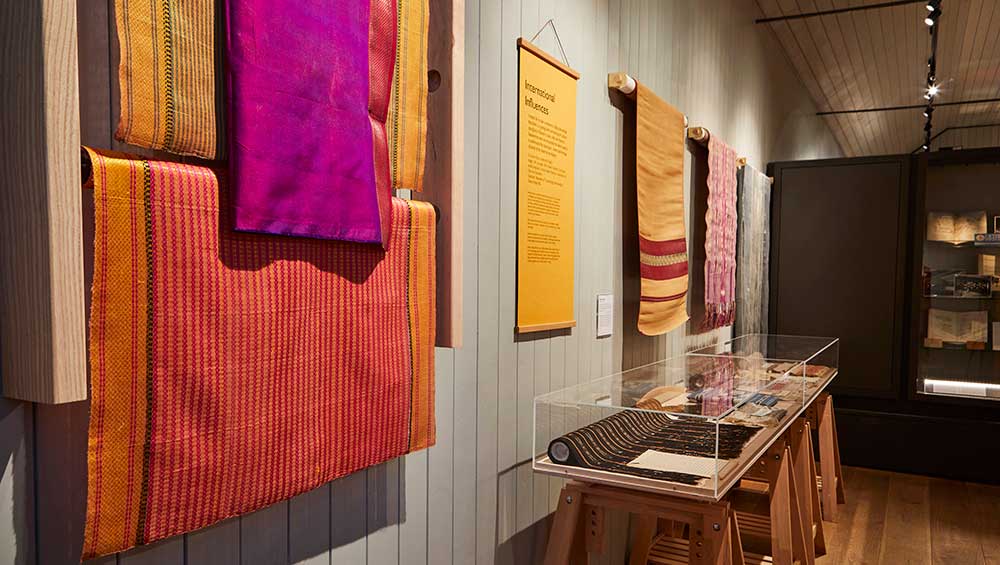
Double Weave: Bourne and Allen’s Modernist Textiles, installation view, Ditchling Museum of Art and Craft, 2023. Photo: Tessa Hallmann.
Ditchling Museum of Art and Craft
16 September 2023 – 14 April 2024
by BETH WILLIAMSON
You may never have heard of Hilary Bourne (1909-2004) or Barbara Allen (1903-72). As textile designers and makers, they ran a contemporary textile company from 1936 until Allen’s death, making a significant contribution to 20th-century design and modernism. They lived and worked together, partners in life and creative practice. Bourne co-founded the Ditchling Museum of Art and Craft with her sister Joanna in 1985, which is one reason for the present exhibition. The curators and researchers behind the exhibition’s realisation reveal Bourne and Allen’s lives along with those of other women in their professional networks. They ask how these two women can, even now, remain unacknowledged in histories of British modernist art and design. Their invisibility could be because they were women working in craft disciplines, rather than fine art. It could be because textiles, their area of expertise, continues to be thought of as less significant than, say, architecture or graphic design. It may be because modernism continued to focus on male-dominated design fields. Whatever the reason, Bourne and Allen achieved so much more than has ever been acknowledged.
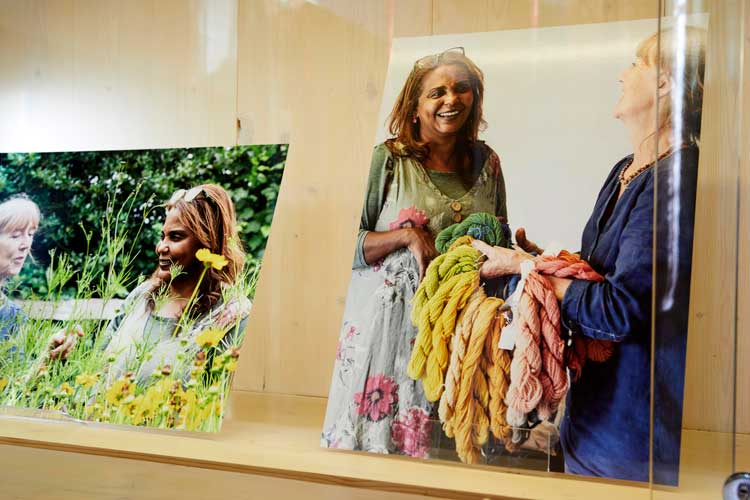
Double Weave: Bourne and Allen’s Modernist Textiles, installation view, Ditchling Museum of Art and Craft, 2023. Photo: Tessa Hallmann.
Double Weave is a truly collaborative effort, a genuine example of research, co-curation and production where each contribution is fully acknowledged and celebrated. On this, the 10th anniversary of the gallery’s redevelopment, it is a nice touch that EJ Scott, the exhibition’s co-curatorial lead, brought together a team of 10 women (one for each of those 10 years), all of whom have a professional interest in the history of art, design, fashion and textiles in the local area. Yet, this story isn’t one of local interest alone, it is of national and international significance too.
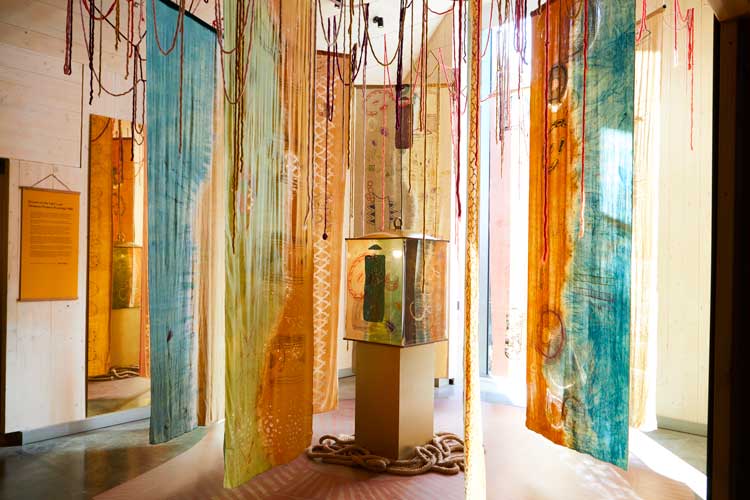
Double Weave: Bourne and Allen’s Modernist Textiles, installation view, Ditchling Museum of Art and Craft, 2023. Photo: Tessa Hallmann.
Bourne had travelled from India to England with her family as a small child. Later, as a young woman, she travelled to Palestine to support her sister Marjorie with her new baby. It was here that Bourne learned to weave and first encountered indigo dyeing. As a couple, Bourne and Allen lived and worked in London and Yorkshire, they travelled extensively in Europe, America and the Caribbean, as well as Iran and Japan. On many of their travels, the pair visited weavers, spinners and other craftspeople, paying attention to and sometimes being taught the practices they used in their making.
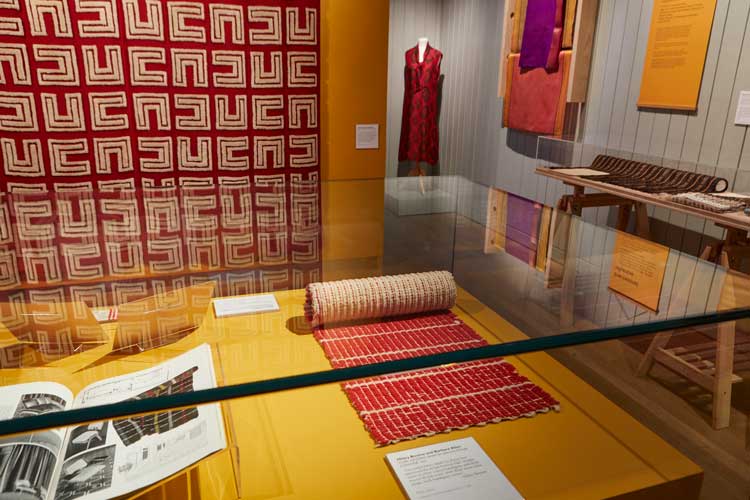
Double Weave: Bourne and Allen’s Modernist Textiles, installation view, Ditchling Museum of Art and Craft, 2023. Photo: Tessa Hallmann.
In the 1940s, Bourne and Allen were already making tweed for Fortnum & Mason, furnishing fabric for Heal’s and scarves for Liberty. One of the most significant projects for them, however, was the modernist textiles they designed and made for the Royal Festival Hall in London as part of the Festival of Britain in 1951. At that time, the couple were living and working in London with a strong circle of clients visiting their Regent’s Park studio. One such client was Sadie Speight. Speight was an architect and interior designer in her own right and was the wife of Leslie Martin, the architect responsible for the design of the Royal Festival Hall (RFH). Bourne and Allen were commissioned to make the fabrics, particularly the heavy backdrop curtains in a bold red-and white design for the boxes in the auditorium.
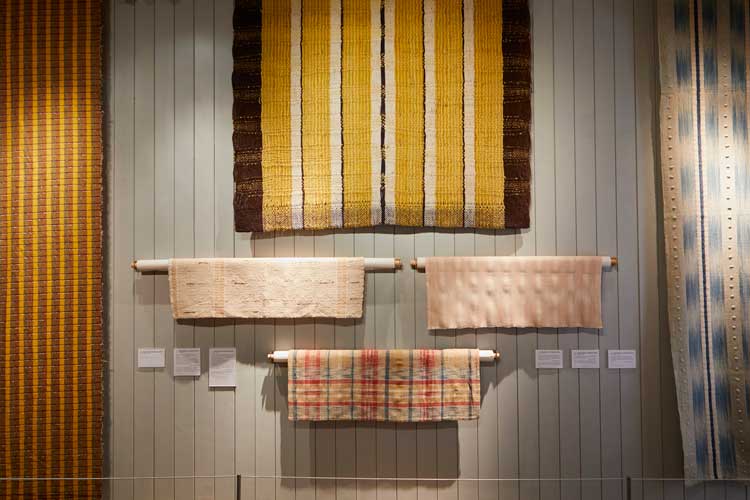
Double Weave: Bourne and Allen’s Modernist Textiles, installation view, Ditchling Museum of Art and Craft, 2023. Photo: Tessa Hallmann.
One sample length of fabric for another RFH curtain design shows the care that the two women took in their design and making. As Bourne explained: “Fine white wool from Brora, Scotland – thick handspun. Stripes in indigo blue; weft yellow, madder red and blackberry tips (these were festival colours) for dark grey; vegetable dyes; double-sided to avoid the need for lining.” That double-sided construction is known as double weave, hence the title of the present exhibition that, importantly, reinserts Bourne and Allen into RFH histories, and not before time.
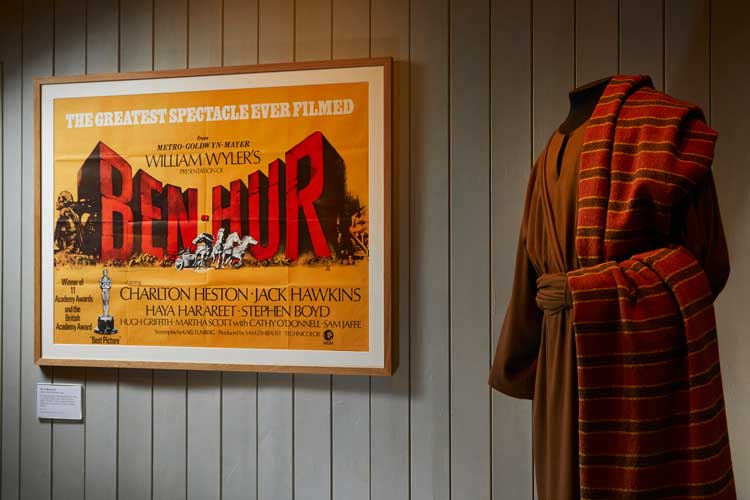
Double Weave: Bourne and Allen’s Modernist Textiles, installation view, Ditchling Museum of Art and Craft, 2023. Photo: Tessa Hallmann.
In the 1950s, these women pioneered the use of Lurex, then a new modern filament, and they were commissioned to design and make the fabrics for the 1959 film Ben-Hur. Their vegetable-dyed loom-woven cloth was well suited to Elizabeth Haffenden’s designs for soft-belted tunics and capes. Haffenden won an Academy Award for best costume design, colour. Sadly, the names of Bourne and Allen do not even appear among the film credits for costumiers and textile-makers.
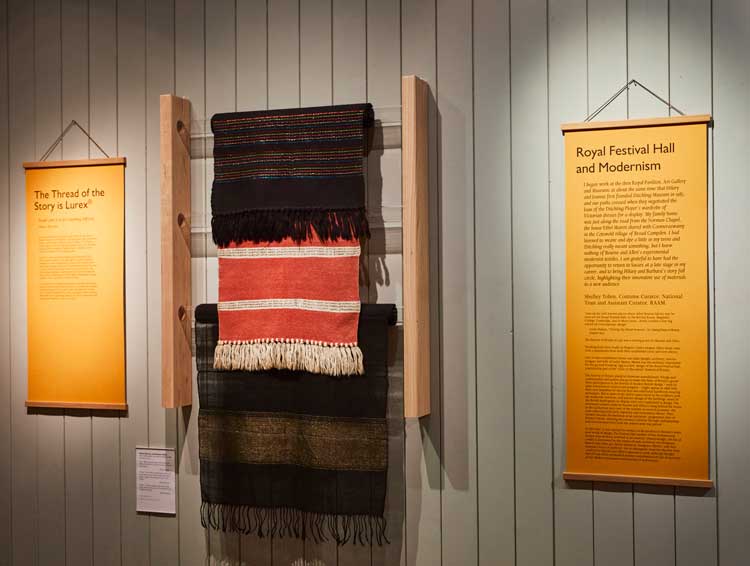
Double Weave: Bourne and Allen’s Modernist Textiles, installation view, Ditchling Museum of Art and Craft, 2023. Photo: Tessa Hallmann.
I have never seen an exhibition with such extensive textual information on the walls and some might say it is too much. I would say it is an act of generosity when its subjects are so little known. Bourne and Allen were part of complex personal and professional networks, difficult to map and to fully appreciate because of their lack of visibility and acknowledgement. It is because of the sharing of extensive information alongside material exhibits that visitors can navigate and begin to understand the material in front of them. This strategy allows space for viewers and readers in other ways too. An immersive installation by the textile artist Omeima Mudawi-Rowlings features textiles coloured with natural dyes deploying techniques pioneered by Bourne and Allen. Further, it explores Mudawi-Rowlings’ own experience as a Black deaf artist with Sudanese heritage, layering text and images in English, British Sign Language and Arabic.
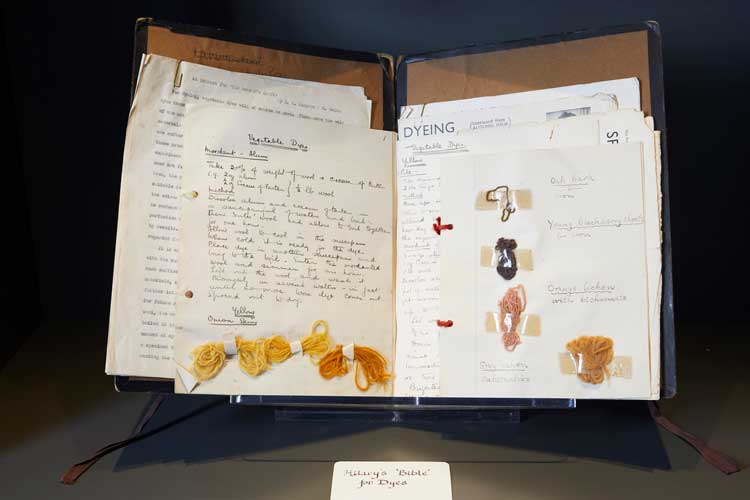
Double Weave: Bourne and Allen’s Modernist Textiles, installation view, Ditchling Museum of Art and Craft, 2023. Photo: Tessa Hallmann.
Visitors are encouraged to walk through the installation and touch the textiles, so inserting themselves in the narrative in a literal way. Local Sussex weaver and dyer Poppy Fuller Abbott created woven textiles in the style of Bourne and Allen as handling samples for visitors who might develop a tactile understanding of the designs, processes and materials in question. A documentary film of Abbott at work is a chance to better understand those processes. Ultimately, this exhibition acts to rewrite queer design histories and to highlight the significance of design and craft for modernism more broadly. The focus might be one couple, Bourne and Allen, but the implications are enormous for our understanding of modernism, the place of largely domestic craft within that, and surely a renewed impetus to seek out other invisible histories that will further refine and enrich our understanding of the past and the present.